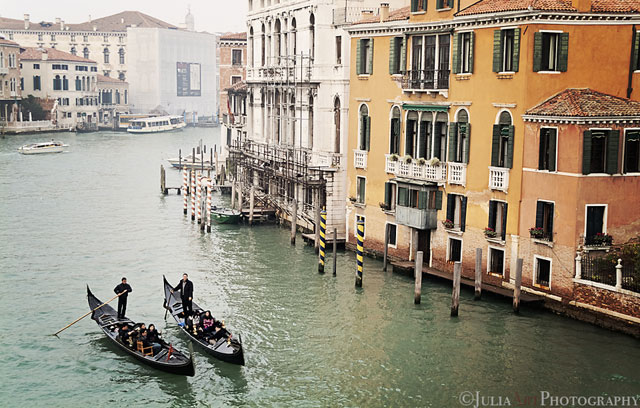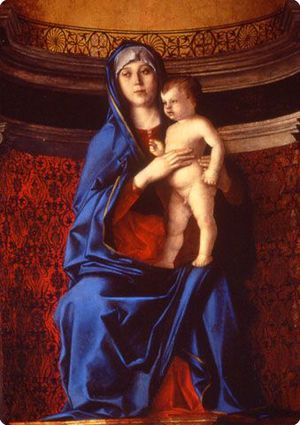
Art: colors & shapes
When you stroll through Venice, you might notice that it has a very particular architecture. Thanks to its strategic position, the city was part of an important trading route with other major centers of the past: Byzantine Constantinople and Islamic Cairo. The result is that Venice’s architectural style is a fusion of both Byzantine and Islamic forms overlaying a Latin Christian foundation.
The first signs of Venetian figurative art can be seen in the Cathedral of Torcello, Santa Maria Assunta, where the mosaics in the chapel’s vault are dated back to the 9th century. Between the 10th and 12th century, the Byzantine and the Christian traditions influenced Venetian art, as you can admire in the decorations of St Mark’s Basilica (Byzantine) and the Mosaic of The Last Judgment in the Cathedral of Torcello (Christian).
Even painters produced works of art that distinguished themselves for merging traditions and cultures. The first truly Venetian artist who made a name for himself was Paolo Veneziano, mixing Gothic, Byzantine and modern elegant styles (early 1300s). Later, the Venetian school was characterized by a great fantasy in decoration with brilliant golds and bright colors. It gained importance with great international artists who lived in Venice, such as Gentile da Fabriano, Michelino da Besozzo and Antonio Pisanello.
Giovanni Bellini is hailed as the “Patriarch” of Venetian painting. His masterpieces can be found in the Churches of Santa Maria Gloriosa dei Frari, San Giobbe, San Zaccaria and San Giovanni Crisostomo. His brother, Gentile Bellini, was sent to Istanbul by the Serenissima Republic in response to the request made by Sultan Mohammed II to have a great portrait painter: his portrait now hangs in London’s National Gallery! Tiepolo was the most important Venetian painter in the 18th century, which was also the age of local landscape artists such as Canaletto, Marieschi and Bellotto, among others.
Music, the voice of the soul
Something not many tourists know is that Venice has played an important role in the development of music in Italy, to the point that the medieval Maritime Republic of Venice was often popularly called the “Republic of Music”.
During the 16th century, Venice became one of the most important musical centers of Europe, marked by the Venetian school and it characteristic style of composition, as well as the development of the Venetian “polychoral” style under composers such as Flemish Adrian Willaert.
By the end of the 1500s, the splendor of Venice’s music was renowned all across Europe. An example of this ‘colossal style music’ is the music arranged by composers Andrea and Giovanni Gabrieli, who used multiple choruses and instrumental groups.
During the Baroque period, Venice was also home to many famous composers such as Antonio Vivaldi, Ippolito Ciera, Giovanni Picchi and Girolamo Dalla Casa. They had a fundamental impact in the development of Opera in Venice and the opening of many historic theaters, such as Teatro Tron (the first opera house ever opened to the public), Teatro di SS. Giovanni e Paolo and Teatro San Moisè.
Music is a very particular aspect of Venice’s history that is definitely worth exploring when visiting the lagoon town. A special musical itinerary designed by Italian Special Occasions DMC is guaranteed to give you goose bumps and to fill your soul with emotions through the following experiences and visits:
- Museum of Music, located in San Maurizio Church, featuring a splendid collection of musical instruments and handmade violin masterpieces from the 18th century
- Confraternity of Saint Rocco, a famous building featuring the work of Tintoretto
- Peggy Guggenheim Collection, the most important museum in Italy for 20th-century European and American art
- the sixteen churches of the Chorus, which house the largest collection of sacred masterpieces by Tiepolo, Veronese, and Tiziano
- Fondazione Querini Stampalia, a noble Venetian residence where ancient and contemporary meet)
- the concert season of the Interpreti Veneziani, internationally-acclaimed artists who bring the art of Vivaldi to life.
Uncovering the secrets of the gondola

The earliest recorded use of gondole in Venice dates back to the 11th century. In the past, they were colored in different ways, until a law from the 16th century forced the boats to be painted black, in an effort to stop a competition for the most flamboyant colours and ornamentation among the nobility.
Even though gondole are made by hand, they are highly uniform: they all weigh 700kg, have 280 component pieces and use eight types of wood – oak, elm, lime, larch, fir, cherry, walnut and mahogany. While squeraroli and carpenters are in charge of building the main structure of the boat, artisans create other parts in workshops and laboratories. For example, the specialist remeri create the oars and the forcola (the typical Venetian rowlock) with great skill and ability.
This animated video by TED-Ed offers an entertaining and colorful insight into the history of the gondola, including how they became the local trademark transportation.
Special events in Venice
Are you planning a special occasion in Venice? Make it unforgettable by offering your wedding guests or corporate clients a trip with authentic activities and a unique way of experiencing local traditions and history…. Have Venetian music artists be part of your event; join an expert artisan in the creation of typical handmade Carnival masks; let us help your imagination in the creation of your dream occasion! Contact Italian Special Occasions DMC now for your customized quotation



